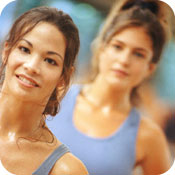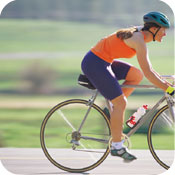
What About Diastisis Recti?
A spreading of the midline of the abdominal wall, it is usually detected in later pregnancy, and is present if you can feel a separation of greater than three fingers. The extent of diastisis should be checked three days postpartum by lying on your back with knees bent, placing fingers in midline of abdominal wall and lifting your head up. Feel for the separation below your fingertips; if it's greater than three fingers, make the exercise modifications outlined below until the diastisis is corrected.
EXERCISES TO STRENGTHEN YOUR CORE
Below is a list of exercises to begin within 24 hours postpartum (from Essential Postpartum Exercises by Elizabeth Noble, Physical Therapist).
VAGINAL BIRTH
Begin with only a few repetitions of each and increase as tolerated.
Phase 1
- Diaphragmatic breathing (Abdominal tightening on outward breath): Lying on your back, place your hands over your abdomen. Inhale and allow your belly to rise as it fills with air. Exhale through your mouth as you tighten your abs, pulling them in towards your spine. Your stomach should flatten, not bulge, as you exhale.
- Kegels (Pelvic floor contractions): Can be done in any position. Tighten and hold for 5 seconds. Do several times a day.
- Pelvic Tilt: While lying on your back with your knees bent, tilt your pelvis backward as you tighten your abs and exhale. Try to bring your belly button to your backbone as you push your low back into the mattress/floor. Hold for 5 seconds, inhale, and relax.
- Stretch out the kinks: Lie on your back with arms and legs out straight, palms up. Bend at the ankles so toes are aiming for the ceiling, tighten thigh muscles and push knees into the bed. Pull your abdominal muscles in and flatten your back. Squeeze your shoulder blades together and elongate your neck. Press your hands back into the bed and hold this for a few seconds, then relax. This allows your muscles to contract isometrically (without changing length), which is safe on the body and provides an easy readjustment to normal posture after birth.
- Active posture check: Standing - tuck your chin in to elongate the neck, pull your shoulders down and back, tighten your abdominal muscles while pulling your belly into your backbone, tighten your pelvic floor, keep knees soft, and increase the arch in your foot.
Phase 2
- Bridges: Lying on your back with knees bent, contract your abdominal, buttock, and pelvic floor muscles, and raise hips up off the floor. Hold for 5 seconds and relax down slowly. The farther your feet are from your buttocks the more challenging it will be. Bridging can also be progressed by lifting one leg while up in bridge position - but you must be able to keep hips level to do this.
- Heel Sliding: Lying on your back, tighten your abdominal muscles and do a pelvic tilt. Slowly slide out one leg at a time while tying to maintain your pelvic tilt. You can progress to sliding both legs out together as long as you can keep the pelvic tilt and not allow the back to arch. Always bring legs back one at a time.
Phase 3
Continued ›
|







Member Comments